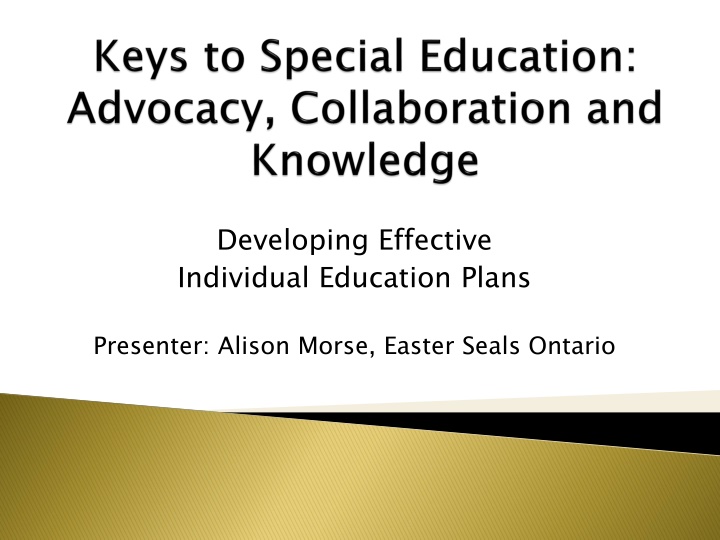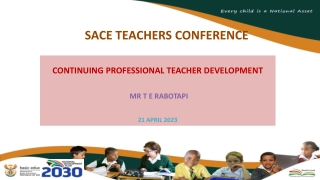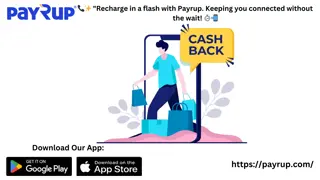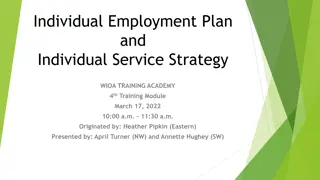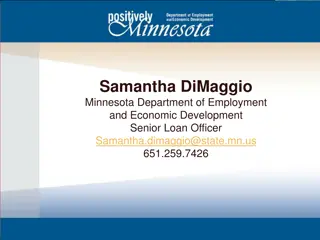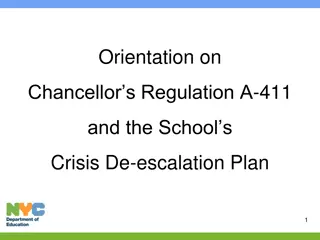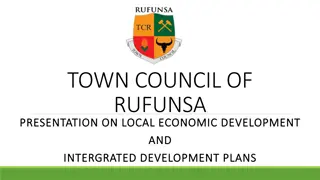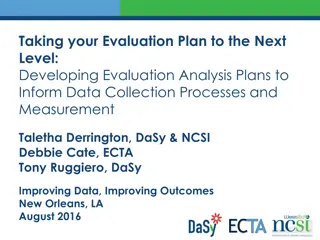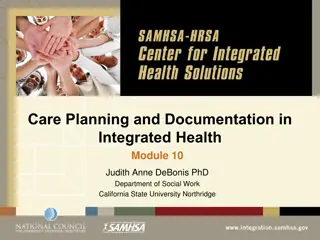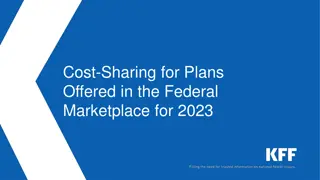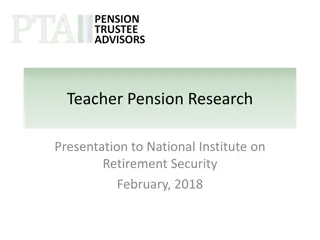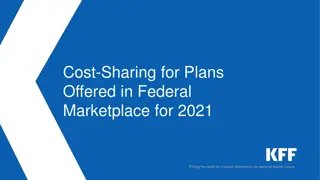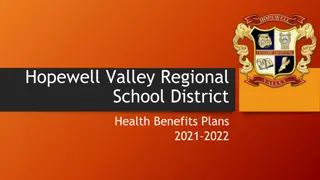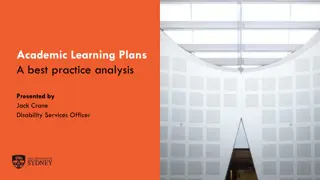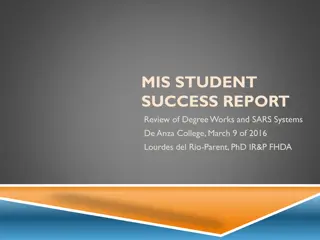Developing Effective Individual Education Plans
Presenter: Alison Morse from Easter Seals Ontario will cover the parent role in Individual Education Plan (IEP) development and elements of effective IEPs in a one-hour session. Public schools' requirements for IEPs, IPRC, and IEP significance will be discussed.
Download Presentation

Please find below an Image/Link to download the presentation.
The content on the website is provided AS IS for your information and personal use only. It may not be sold, licensed, or shared on other websites without obtaining consent from the author.If you encounter any issues during the download, it is possible that the publisher has removed the file from their server.
You are allowed to download the files provided on this website for personal or commercial use, subject to the condition that they are used lawfully. All files are the property of their respective owners.
The content on the website is provided AS IS for your information and personal use only. It may not be sold, licensed, or shared on other websites without obtaining consent from the author.
E N D
Presentation Transcript
Developing Effective Individual Education Plans Presenter: Alison Morse, Easter Seals Ontario
Presentation Goals Presentation Goals 1. To identify the parent role in Individual Education Plan (IEP) development 2. To identify elements of effective IEPs
The session is only for one hour and questions are welcome If I can t answer your question today I will follow up with you after the Conference I will not take any specific questions related to individual situations, although I may be able to talk to you after the end of the session, or by e-mail.
All public schools are required to teach the provincial curriculum. The provincial curriculum identifies the learning expectations of each grade and course, that is, what the student will know at the end of each grade or course. Students are required to have an IEP when their learning expectations will be different from the grade curriculum. provincial curriculum. learning expectations for each component
Identification, Placement and Review Committee (IPRC) and Individual Education Plan (IEP) are both important and serve different purposes Presentation will not discuss IPRC today other than as it relates to IEP IPRC process is legislated through Regulation 181/98 and decides whether student is exceptional and determines their placement When a student is identified as Exceptional the school board has a legal responsibility to meet the student needs A student who has been identified as exceptional must have an IEP developed within 30 days
Individual Education Plan (IEP) helps teachers and other staff to understand your child s needs and provides a plan of how they can help the student to learn. Individual Education Plan (IEP) is a written plan, living working document. IEP is based on assessment of student strengths and needs The IEP must be reviewed regularly and should change to reflect student progress.
A student must have an IEP if the student has been identified through the Identification, Placement and Review Committee (IPRC) An IEP may be developed if the student requires accommodations to access the curriculum; modifications to the grade curriculum; or an Alternative Program An IEP is required if student has accommodations that will also be required for Provincial testing (Grade 3 or 6 or Grade 9 Math and Grade 10 Literacy Test)
Your childs strengths and interests Feelings expressed by your child about school Your thoughts about your child s successes and challenges at school Information about your child s development and special needs Any recent changes or challenges at home Strategies and approaches used at home Any reports from Doctors, therapists, specialists, child care providers Special equipment or supports required by your child
Reason for developing the IEP Student Profile IPRC information, including exceptionality, placement decision and most recent date Subjects or courses to which the IEP applies Elementary exemptions with rationale For secondary students, course substitutions and attainment goal, Ontario Secondary Diploma, Certificate or Certificate of Achievement
Relevant test or assessment results Student s strengths Student s needs Student s current level of achievement List of Accommodations required to access the curriculum Special Education Program Student s Annual Goals Specific learning expectations for a Modified or an Alternative Program Teaching and Assessment strategies Human Resources Health Support Services Transition plans
IEP should include a brief summary of relevant assessments as well as the source and date of the assessment May include Educational Assessments, Professional Assessments from Speech- Language Pathologists or Occupational Therapists, Psychologists or Doctors Parents should check carefully to make sure the most recent assessment information is included
Information Source Information Source Date Date Summary of Results Summary of Results Educational Assessment November 2015 Board Benchmark Assessments indicate that reading skills are at grade level. Written output is slow. Fine motor skills are significantly delayed. Writing aid and adapted equipment necessary for fine motor activities. Gross motor skills significantly delayed. Diminished flexibility and postural support. Occupational Therapy June 2015 Physiotherapy October 2015
The IEP student strengths and needs are based on assessment reports There should be a direct link between the assessment information, the strengths and needs listed The IEP should list student strengths, especially those that should be considered in planning to meet the needs. A student may have a number of needs which should be documented. However, a few priority needs may be targeted at each report period.
Reading language skills (writing), word recognition skills Communication expressive language skills, self-advocacy skills Learning Skills listening skills, attention skills Behaviour management Reading: comprehension, expressive Communication: oral receptive Learning Skills: organizational skills, Behaviour: self-control skills, anger-
Accommodations supports and/or services that are required in order for the student to access the curriculum and demonstrate learning. Accommodations do not alter the provincial learning expectations for the grade level. An accommodation may include a FM system for a child that is hearing impaired or the Picture Exchange Communication System (PECS) for a non-verbal child. Accommodations are the strategies,
Instructional technology, such as text to speech software; concrete/hands on materials; rewording rephrasing of information Environmental strategic seating; quiet setting; Assistive devices or adaptive equipment Assessment responses, including audio tapes; Assistive technology, such as speech-to-text software (Page 29 of IEP Resource Guide (2004)) Instructional- Note taking Assistance; assistive Environmental Alternative work space; Assessment Verbatim scribing; oral
Instructional Accommodations Speech Generating Device Communication Book Instructional Accommodations Environmental Accommodations 4 Wheeled walker Environmental Accommodations Assessment Accommodations Speech Generating Device Communication book Assessment Accommodations Velcro secured knee braces Customized chair Laptop with modified large key keyboard Assistive Writing Aid Slant board Stand by supervision for safety in gym, hallways, schoolyard Assistive writing aid Activity pacing, options for breaks in gym
Modifications to the grade level expectations for a subject or course to meet the needs of the student. For core subjects, such as Math and Language, the expectations may be from another grade level (higher or lower). For content subjects, such as Social Studies or History, the modifications may include significant changes to the number and/or complexity of the learning expectations. Modifications refer to the changes made
Alternative Learning Expectations learning related to skill development in areas not represented in the provincial curriculum. The learning expectations represent a specific program or course taught to the student. For example, a Braille training program for a student who is Blind or Low Vision, Social Skills for students with Autism, or Self- Regulation for student with behaviour challenges Alternative Learning Expectations refer to
Baseline Level of Achievement -usually from June Report Card Annual Program Goals what the student can reasonably expect to achieve in school year Program for this term (semester): Learning Expectations specific and measurable (from Ontario Curriculum for modified program) Teaching Strategies to be used by instructor in classroom Assessment methods how achievement will be measured
Subject or Course/Code or Alternative Skill Area Subject or Course/Code or Alternative Skill Area Baseline Level of Achievement (usually from previous June report card) Baseline Level of Achievement (usually from previous June report card) Baseline Level of Achievement for Alternative Skill Areas: Baseline Level of Achievement for Alternative Skill Areas: Prerequisite secondary course (if applicable): Letter/Grade Mark: Curriculum Grade Level: Annual Program Goal(s): A goal statement describing what the student can reasonably be expected to accomplish by the end of the school year (or semester) in a particular subject, course or alternative skill are. Annual Program Goal(s): A goal statement describing what the student can reasonably be expected to accomplish by the end of the school year (or semester) in a particular subject, course or alternative skill are. Learning Expectations Teaching Strategies Assessment Methods
Includes teaching and non-teaching Type of Service teacher, teaching assistant, Speech-Language Pathologist, Physiotherapist, etc. Frequency or Intensity for Board staff number of minutes and sessions over what time period (weekly, monthly, etc) Location school yard, etc. Type of Service Special education resource Frequency or Intensity for Board staff - Location classroom, resource room, gym,
Health services being provided in the school setting may include: Nursing Physiotherapy Occupational therapy Assistance with mobility Feeding Lifting and positioning Catheterization or toileting Medication administration
Policy/Program Memorandum (PPM)156 requires documentation of supports for student transitions May include activity to activity, class to class, grade to grade, school to school Must include planning for life after high school (in the community, employment or post secondary education) starting at age 14
Transition Plan Transition Plan No No Yes Yes Long Term Goal(S) To independently and consistently communicate clearly in both academic and social situations during the school day as preparation for increased expectations for a full rotary schedule in the Intermediate Division and Secondary School. Actions for Actions Long Term Goal(S) To independently and consistently communicate clearly in both academic and social situations during the school day as preparation for increased expectations for a full rotary schedule in the Intermediate Division and Secondary School. Actions for Actions Person s Responsible Person s Responsible Actions Actions Timelines Timelines
IEP must be reviewed each term or semester For a review within the school year there may be only minimal changes: New information about the student New courses at secondary schools New or changed special education program for the term based on assessment results For new school year, review must reflect new grade and subjects, as well as any new information about the student
Parent role in IEP Development and Monitoring Parents can provide information about the child s strengths and needs, including relevant reports Parents can provide information on strategies that help the child at home Parent to sign and provide feedback on the Parent Consultation form Parents can monitor the IEP implementation and provide feedback on what is working or creating challenges Note: Principal is responsible for IEP development and for signing finished document
Log of Parent/Student Consultation and Staff Review/Updating Date (Indicate parent/student consultation or staff review) Log of Parent/Student Consultation and Staff Review/Updating Activity Outcome Involvement of Parent/Guardian or Student I was consulted in the development of the IEP I I declined the opportunity to be consulted I I have received a copy of this IEP Parent/Guardian and Student Comments: Signature Date
Key Ministry of Education Resources Regulation 181/98 For the Identification, Placement and Review Committee Process Individual Education Plan (IEP) A Resource Guide (2004) Planning Entry to School A Resource Guide (2005) Shared Solutions A Guide to Preventing and Resolving Conflicts Regarding Students with Special Education Needs (2007) Key Ministry of Education Resources School Board Resources: Parent Guide to the IPRC Special Education Report Program Brochures or Guides School Board Resources:
Parents need to be informed about: Student strengths and needs Special Education resources and processes Parent Role in the IEP Parent s Rights and Responsibilities Parents can work with educators to support student success: By sharing their extensive knowledge of the child As the liaison which links all of the service providers Collaborating to build dynamic and appropriate programs for exceptional students. Parents need to be informed about: Parents can work with educators to support student success:
Contact Information: Alison Morse e-mail to amorse@easterseals.org Contact Information: Easter Seals Kids at School Website: www.education/easterseals.org Easter Seals Kids at School Website: www.education/easterseals.org Ministry of Education Website: www.edu.gov.on.ca Ministry of Education Website: www.edu.gov.on.ca Thank You!!! Thank You!!!
